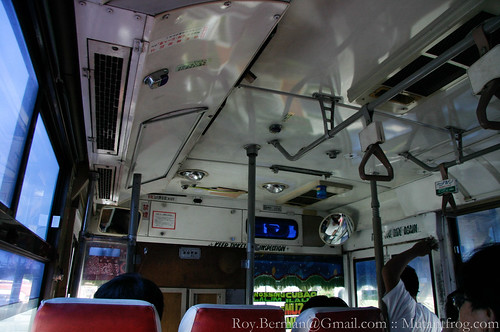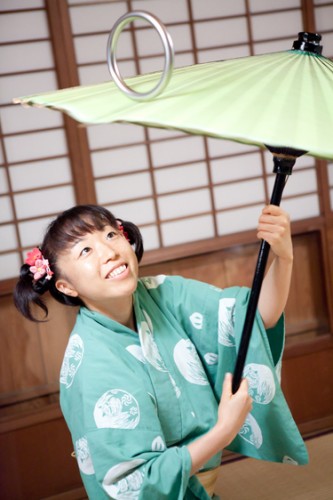Since World War III is taking a while to build up in Korea, here’s some lighter fare for enjoying the end days. Video is SFW but audio may not be.
Month: November 2010
Kyoto City bus in Manila
Curzon’s post on spotting a large number of used Japanese trucks and other vehicles in Lebanon reminded me of how many I’ve seen in my visits to the Philippines. In fact, the very first automobile I entered in the country was a former Kyoto City bus, when, upon leaving the airport, I went across the street and grabbed the very first bus that seemed to be going in the general direction of downtown Manila. It turns out that I actually grabbed a few photos of the signage, so here they are. I didn’t get any photos of the outside of the bus, as I had no idea that it was going to be anything special inside; as far as I can recall the exterior had been painted over completely so that it looked like any other heavily used commuter bus.
These were taken on November 25, 2005.
At the time of the trip I was living in Taipei, and had not been to Japan – much less Kyoto – for about a year and a half. Needless to say, finding myself in a transplanted Kyoto City bus in Manila, with all of the accouterments intact, was a surreal experience.
I don’t recall if the stop buttons still functioned.
This badge clearly labels it as a Kyoto bus, with the bus registration number.
This plate is the really interesting one. It reads: “Auto reconditioning, July 12, Heisei year 6 (1996), Hankyu Bus.” Hankyu is one of the major transportation/retail conglomerates of the Kansai region, centered in Osaka, which I discussed in some detail in a previous post. They do run ordinary public buses, but not in Kyoto City. At least not currently; I have no idea about the early 90s. A quick glance at their website did not turn up any information on how they deal with used buses, or if they happen to have a division devoted to reconditioning and exporting used vehicles.
The Chukosha of Lebanon
I just got back from a trip around Lebanon.
One characteristic of the country is utter chaos on the roads. I’ve seen some bad driving in my day — rural China, Vietnam, and Saudi Arabia being some of the worst — but I would venture to say that driving in Lebanon tops all of them, with the added factor that the roads in the country are absolute rubish (as one colleague told me, roads in Lebanon aren’t built to last longer than a few years, as that’s about how often the Israelis bomb the country). Most of the cars on the road are ancient Mercedes and Renaults, which, while having a certain retro cool, are rickety and unreliable rides on the road. According to people I spoke with, most cars in Lebanon come from France.
But clearly not all of them. I saw a number of trucks and vans with Chinese, Korean and Japanese writing on the side. I snapped a shot of one such truck and thought it worth sharing with MF readers:
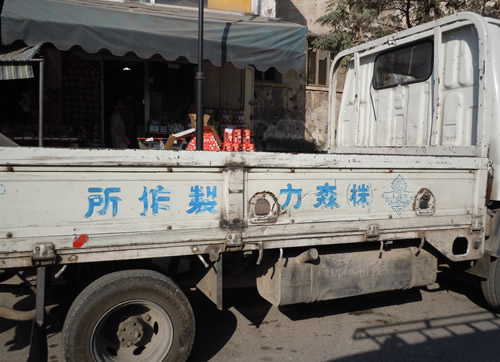
Interestingly enough, 森力製作所 is a Nagoya company, and one other truck I saw (out of perhaps half a dozen trucks with Japanese letters) was a Nagoya city municipal vehicle. I wonder if Nagoya and Beirut have sort of special relationship when it comes to exporting second-hand trucks?
The Yamba Dam is back on
Just over a year ago, I visited the Yamba Dam (together with MF blogger Ben) to see with my own eyes the mega-dam project in the mountain valleys of western Gunma. The DPJ immediately halted the project when they came into power in September 2009 due primarily to the project cost. But the dam construction had burned through more than 70% of its US$4 billion budget by mid-2009. The trip was interesting, and it reinforced my view that stopping construction at this late stage was a mistake. Indeed, my exact words on this blog were:
Frankly, no matter how hard Transportation Minister Maehara and the DPJ hold out on refusing to construct the dam, I can’t possibly see how the project cannot be finished. At best the DPJ can delay the plan a year or two.
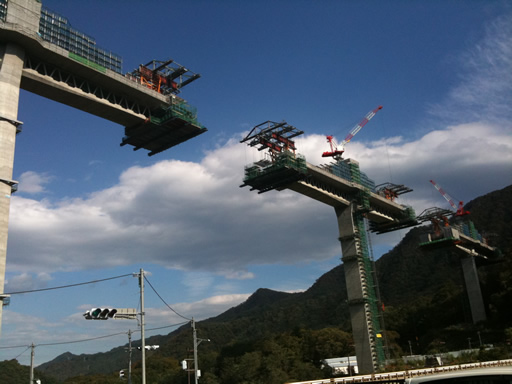
That prediction is on track to be correct. Minister for Land, Infrastructure, Transport (and Tourism!) Sumio Mabuchi has announced that the government is reexamining the project to see if it is viable. While not an express reversal of policy, the announcement has been widely interpreted in the press (and not denied by the administration) as a soft way of announcing that the DPJ administration is withdrawing the pledge to scrap construction of the dam.
Tokyo Governor Ishihara, who along with many other regional local leaders was outraged by the cancellation of the project, had a somewhat predictable reaction, which can best be translated into English as, “Well, duh!”
The opposition LDP is loudly denouncing the DPJ as irresponsible, pursuing policies without proper thought, and other general incompetence that I’ve long-described as cognitive dissonance that makes the party unfit to govern. Whether it be the reconsideration of the reconsideration of the reconsideration of the Futenma US base in Okinawa, the Justice Minister’s moratorium on the death penalty followed by carrying out executions, and now reversal of the Yamba Dam decision, we see a common theme — the DPJ is a flailing mess when it comes to policymaking and set new standards for flipflopping.
DAIKAGURA
Some of you may know that I run regular fundraiser for Polaris Project, Japan’s only NGO devoted solely to fighting human trafficking. I’m running my BIGGEST ONE EVER tomorrow in Harajuku and there are still SEATS AVAILABLE.
The event will feature the Edo Daikagura Troupe, masters of daikagura, a performance/juggling art that dates back to the Heian Period. Needless to say, these guys are very very good and their act is incredible! For more detail, check out the Metropolis Magazine feature I wrote on it some weeks ago.
We also got coverage in the JAPAN TIMES today!
I’m posting the flier beneath the break. If any readers are interested in coming (and meeting me and other MF ppl) please RSVP to the e-mail address near the bottom.
“Are we Japan?” What Japan are you talking about?
Via Andrew Sullivan, a terrible, terrible example of punditry asking if the US is on the verge of a Japan style “lost generation,” which includes the following particularly wretched paragraph, in which John B. Judis of The New Republic shows he knows nothing about Japan:
If you want to imagine what American politics will be like, think about Japan…. Japan had a remarkably stable leadership from the end of World War II until their bubble burst in the 1990s. As the country has stumbled over the last two decades, unable finally to extricate from its slump, it has suffered through a rapid of succession of leaders, several of whom, like Obama, have stirred hopes of renewal and reform, only to create disillusionment and despair within the electorate…. That kind of political instability is both cause and effect of Japan’s inability to transform its economy and international relations to meet the challenges of a new century.
Judis here is making a fundamental mistake of confusing Japan’s Liberal Democratic Party majority rule, which began in 1955 and was nearly continuous until last year, with the longevity of Prime Ministers. Needless to say, anybody with even a passing familiarity with post-war Japan is well aware that despite the LDP’s “remarkably stable” monopoly on power, there was far less than “remarkably stable leadership” in the office of the Prime Minister.
Taking a look at the list of PM’s and how many days each of them served, it is obvious that not only were extremely short lived administrations far more common than longer ones throughout the entire postwar period, but that the Junichiro Koizuimi term of 2001-2006 (a total of 1,979 days) was the third longest since WW2, and the longest since Eisaku Satō, who was PM between 1964 and 1972.
Since his factual premise is so obviously false (and I have to run to campus soon) I will not even bother to get into analyzing his equally spurious claim that this “rapid of succession of leaders […] like Obama, have stirred hopes of renewal and reform, only to create disillusionment and despair within the electorate,” much less looking at how crappy his analysis of US politics probably is, but please do fire away in the comments!
First impressions of Katsushika-ku
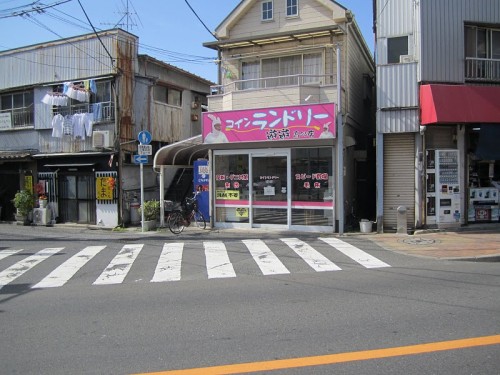
Gaudy bunnyman laundromat near my place
It’s been about two months since I moved from Ayase to Shibamata, an area of Katsushika-ku about a 20-minute drive away. My life since then has been a mix of busy and overwhelming, but as a way to ease myself back into blogging I’ll offer some first impressions of the new neighborhood.
Shibamata is well-known as the setting for the Otoko Wa Tsurai Yo film series. It’s about a guy named Tora-san who works as a traveling salesman whose cantankerous attitude and pratfalls cause mayhem and drama for his family in Tokyo who sells rice dumplings outside Taishakuten, a big temple in the area. He is considered something of a hero to Japanese men who grew up a generation or three ago.
My apartment is maybe 15 minutes on foot from Taishakuten. The main attractions are the exquisite temple and a run-up of shops selling souvenirs and dango rice dumplings. If you had no clue about the movies, the general atmosphere would seem like a scaled-back version of Asakusa except for all the trinkets featuring a guy in a cheap suit and fedora.
Away from the touristy spots, my new place is in many ways not that different from Ayase. Katsushika-ku and Adachi-ku are both considered “shitamachi” (lower-class outlying Tokyo neighborhoods), and my neighborhood does not disappoint on this front. In fact, I live amidst a surprisingly thriving shotengai business district which offers competitive and attractive alternative grocery options to the Ito Yokado by the station, provided you’re willing to visit multiple stores.
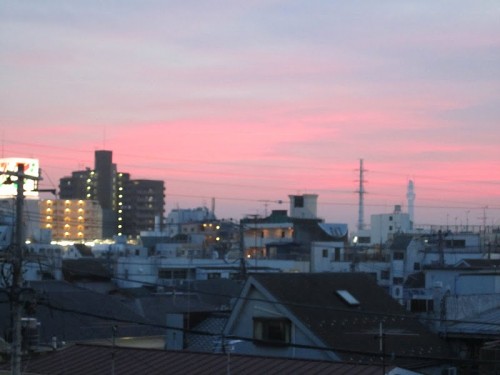
You can see the Sky Tree from my apartment. When completed it will be the world’s tallest… something
Another related similarity is the general slumminess (for Japanese standards). I feel bad saying that though because even though both places feel kind of run down, the people and atmosphere in my new neighborhood are much sunnier. The police say Katsushika-ku has less crime than Adachi-ku (PDF), but by population the smaller Katsushika is pulling its weight just fine (2/3 the population with 3/4 the number of crimes). At the anecdotal level, I have witnessed:
- A crippled old guy escaped from a nursing home, sitting on his butt and pushing himself along on his hands trying to get somewhere (long story short, he had his facility name on his slippers, so I called to make sure they got him).
- Obvious yakuza held a boisterous mikoshi parade around my station.
- Something (probably human) left an enormous crap on the sidewalk one night.
- A local dentist I visited was like something out of the Addams Family or the Saw movies – it was just in this guy’s house, and the office was dank, dark, and cluttered with unused equipment. Half the counter space was taken up by a bonsai tree and a fountain that he must have set up in the 80s.
- Some drunk guy puked in my building’s lobby (oh wait, that was one of my guests…)
To offer a positive spin, these elements add lots of character and should keep our lives interesting. For the most part, it’s a great place to live so far. It’s a quieter neighborhood, many of the local people are friendly, and there’s a really nice public pool and a state-of-the-art central library nearby. And the best part is I am living in a much bigger place, for about the same rent. Having room to swing your arms around is extremely comfortable!
Also, for some reason my new commute on the Keisei line is so much less crowded than most of the other routes into Tokyo. From where I ride it’s often possible to get a seat, and it’s just about never uncomfortably packed.
Anyway, I will keep my eyes open! I have been meaning to go around with my camera to capture some of the local color.

